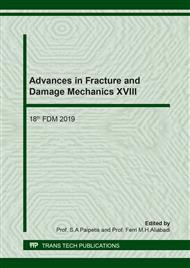p.1
p.7
p.13
p.19
p.25
p.31
p.37
p.43
Numerical Modelling of Plasticity Induced Crack Closure with Rough Fracture Surfaces
Abstract:
A two-dimensional elastic-plastic finite element model was built to simulate the closure of a long fatigue crack with arbitrarily shaped crack faces. The model growth is simulated by the successive mesh splitting along the crack path defined by element edges. To obtain a realistic morphology of the fracture surface, fatigue crack growth experiments with CT specimen made from AISI 304 stainless steel were performed and fracture surface topology was determined using a single camera and a depth-from-focus method. Simulated closing loads and closure lengths for the cracks with rough and smooth faces and for plane-stress and plane-strain conditions are compared. A mismatch of rough crack faces, resulting in an additional contact, is visualized.
Info:
Periodical:
Pages:
7-12
Citation:
Online since:
December 2019
Authors:
Price:
Сopyright:
© 2020 Trans Tech Publications Ltd. All Rights Reserved
Share:
Citation:


